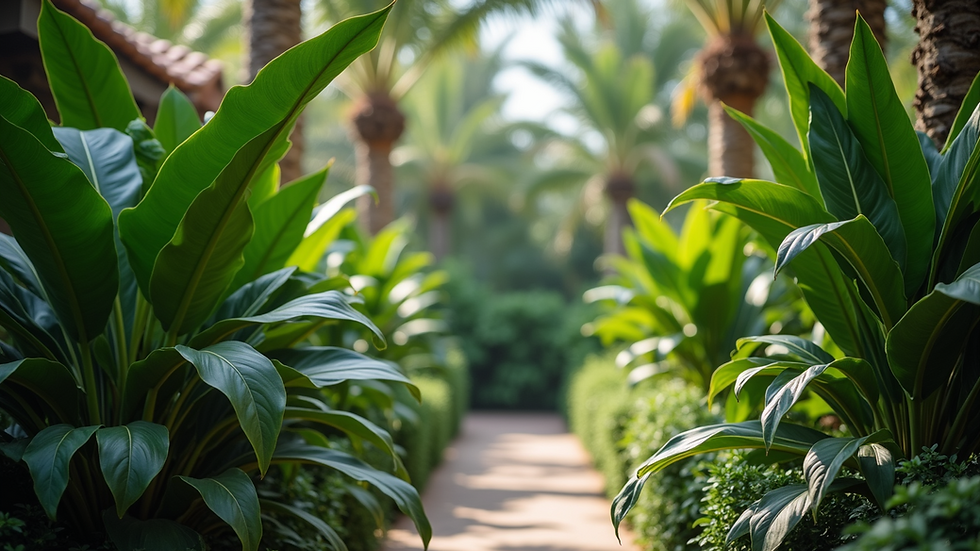Choosing the Right Palm Tree for Your Space
- Brandon Hall

- May 19
- 4 min read
When it comes to adding a touch of tropical elegance to your home or landscape, nothing beats a beautiful palm tree. These versatile plants can transform any space, from patios and pool sides to gardens and commercial properties. However, with so many varieties available, choosing the right palm tree can be a daunting task. This guide will help you navigate the different types of palm trees, their ideal growing conditions, and essential care tips to ensure they thrive in your space.
Understanding Different Types of Palm Trees
There are over 2,500 species of palm trees, but they can be broadly categorized into three groups: fan palms, feather palms, and pine palms.
Fan Palms
Fan palms, like the Chinese Fan Palm or the Washingtonia, have wide, fan-shaped leaves that give them a unique look. They are ideal for landscaping due to their beautiful structure. These palms are hardy and can tolerate a range of conditions, making them great for both tropical and temperate climates.

Feather Palms
Feather palms, such as the Pygmy Date Palm or the Canary Island Date Palm, have long, feathery fronds that droop gracefully. They are often used in smaller spaces or inside homes as decorative indoor plants. Feather palms typically thrive in warm temperatures and require well-draining soil.

Pine Palms
Pine palms, including species like the Pineapple Palm, are characterized by their tall profile and crown of fronds on top. These palms can reach impressive heights and are perfect for providing shade in larger outdoor spaces. They prefer direct sunlight and require regular watering to stay healthy.

Assessing Your Space
Before choosing a palm tree, it's crucial to assess your environment. Consider the following factors:
Climate
Know your climate zone. Some palms can withstand cold winters, while others thrive in tropical climates. If you live in a colder region, look for cold-hardy varieties like the Windmill Palm or the European Fan Palm.
Sunlight
Determine how much sunlight your space receives. Some palms require full sun, while others prefer partial shade. Ensure that the palm you choose is compatible with your light conditions.
Space Availability
Consider the size of your property. Large palms may be unsuitable for small yards or indoor spaces. Measure the area where you plan to plant to make sure the palm will have ample room to grow.
What Month Do You Plant Palm Trees?
Timing is critical for planting palm trees. The best months to plant them depend on your location, but generally, it is ideal to plant palm trees in the spring after the last frost date. This gives the palms a chance to establish their root system before the heat of summer sets in.
In warmer climates, you can plant palms in early fall as well. This timing allows the palm enough time to acclimatize before winter sets in. Always check with local gardening experts or extension services for specific planting times based on your region's climate.
Care and Maintenance Tips
Once you've chosen the right palm tree for your space, it is important to take good care of it to ensure its longevity. Here are some essential care tips:
Watering
Palm trees require consistent moisture but do not like to be waterlogged. Water deeply and allow the top layer of soil to dry out between watering. Depending on your climate and rainfall, this may mean watering every few days or once a week.
Fertilizing
To keep your palm healthy, use a fertilizer specifically formulated for palms. Fertilize during the growing season (spring and summer) for optimal growth. Look for a balanced fertilizer that contains micronutrients like magnesium and potassium, which are beneficial for palm health.
Pruning
Regular pruning helps maintain the appearance of your palm and removes dead fronds that can harbor pests. Cut only the fronds that are brown and dead, as healthy fronds will provide necessary nutrition to the palm.
Pest Control
Be on the lookout for pests like spider mites and scale insects. Regularly check your palms for early signs of an infestation. If you notice any pests, treat the tree immediately with appropriate insecticides or organic solutions like neem oil.
Finding Quality Palm Trees
If you're searching for palm trees to enhance your landscape, ensure you purchase from reputable nurseries. A trusted source will provide healthy plants that are suited to your local area. Look for high-quality options, or explore the variety of palm trees for sale that may be available near you.
Investing time to choose the right palm and nurture it will yield gratifying results as it thrives and beautifies your space.
Adding Value and Aesthetic Appeal
Palm trees not only improve the aesthetics of your property but can also increase its market value. Landscapes with palm trees evoke feelings of luxury and relaxation, making properties more desirable. They can provide shade, act as natural windbreaks, and even attract wildlife such as birds and butterflies.
Conclusion Alternatives
Choosing the right palm tree for your space is about more than just looks. By considering the variety of palm trees available, assessing your specific conditions, and following proper care guidelines, you can enjoy the beauty of these tropical wonders for years to come. Through thoughtful selection and maintenance, you will create a serene environment that enhances your outdoor experience.
As you embark on this journey, remember to regularly evaluate your palm’s health and enjoy the peace and beauty it brings to your surroundings!









Comments